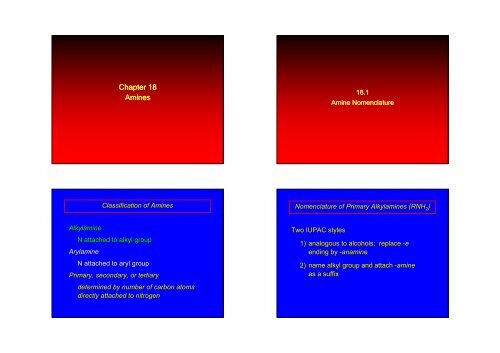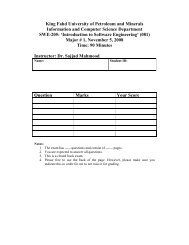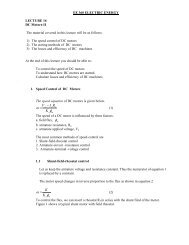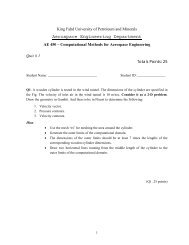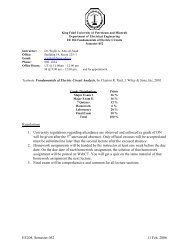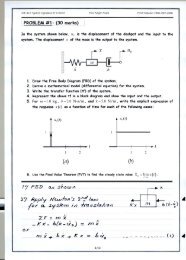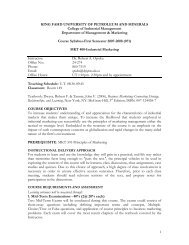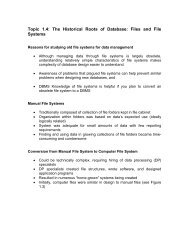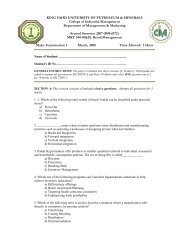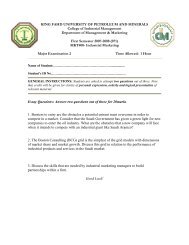Ch18 Amines(pdf) - KFUPM Open Courseware
Ch18 Amines(pdf) - KFUPM Open Courseware
Ch18 Amines(pdf) - KFUPM Open Courseware
Create successful ePaper yourself
Turn your PDF publications into a flip-book with our unique Google optimized e-Paper software.
Chapter 18<strong>Amines</strong>18.1Amine NomenclatureClassification of <strong>Amines</strong>Nomenclature of Primary Alkylamines (RNH 2 )AlkylamineN attached to alkyl groupArylamineN attached to aryl groupPrimary, secondary, or tertiarydetermined by number of carbon atomsdirectly attached to nitrogenTwo IUPAC styles1) analogous to alcohols: replace -eending by -anamine2) name alkyl group and attach -amineas a suffix
Examples: some primary alkylamines(RNH 2 : one carbon directly attached to N)CH 3 CH 2 NH 2ethylamine or ethanamineNomenclature of Primary Arylamines (ArNH 2 )Name as derivatives of aniline.CH 3 CHCH 2 CH 2 CH 3NH 2NH 2cyclohexylamine orcyclohexanamine1-methylbutylamineor2-pentanamineExamples: some primary arylamines(ArNH 2 : one carbon directly attached to N)NH 2Amino groups as substituentsamino groups rank below OH groups and higheroxidation states of carbonin such cases name the amino group as asubstituentFNH 2BrCH 2 CH 3OHOCH 2 CH 2 NH 2HCNH 2p-fluoroaniline5-bromo-2-ethylaniline2-aminoethanolp-aminobenzaldehyde
Secondary and Tertiary <strong>Amines</strong>Name as N-substituted derivatives of parentprimary amine.(N is a locant-it is not alphabetized, butis treated the same way as a numericallocant)Parent amine is one with longest carbonchain.CH 3 NHCH2 CH 3NHCH2 CH 3ClNO 2CH 3NCH 3ExamplesN-methylethylamine4-chloro-N-ethyl-3-nitroanilineN,N-dimethylcycloheptylamineExamplesAmmonium SaltsNHPyrrolidineNH2-methylpyrrolidineNHPiperidineCH 3HNNHPiperazineOH 3 C N CH 3H3,5-dimethylmorpholineONHMorpholineA nitrogen with four substituents is positivelycharged and is named as a derivative ofammonium ion (NH + 4 ).+CH 3 NH 3Cl –methylammoniumchlorideCH 3+N CH 2 CH 3H–CF 3 CO 2N-ethyl-N-methylcyclopentylammoniumtrifluoroacetate
Ammonium SaltsWhen all four atoms attached to N are carbon,the ion is called a quaternary ammonium ion andsalts that contain it are called quaternaryammonium salts.CH 2CH 3+N CH 3 I –18.2Structure and BondingCH 3benzyltrimethylammonium iodideAlkylaminesAlkylamines147 pm112°106°Most prominent feature is high electrostaticpotential at nitrogen. Reactivity of nitrogen lonepair dominates properties of amines.
Geometry at NCompare geometry at N of methylamine, aniline,and formamide.HH sp 3Hsp 2C NH 2CONH 2HPyramidal geometry at sp 3 -hybridized N inmethylamine.Planar geometry at sp 2 -hybridized N informamide.Compare geometry at N of methylamine, aniline,and formamide.sp 3Geometry at Nsp 2Pyramidal geometry at sp 3 -hybridized N inmethylamine.Planar geometry at sp 2 -hybridized N informamide.Geometry at NGeometry at N in aniline is pyramidal; closer tomethylamine than to formamide.Geometry at NHybridization of N in aniline lies between sp 3 and sp 2 .Lone pair of N can be delocalized into ring best if N issp 2 and lone pair is in a p orbital.Lone pair bound most strongly by N if pair is in an sp 3orbital of N, rather than p.Actual hybridization is a compromise that maximizesbinding of lone pair.142.5°142.5°
Electrostatic Potential Maps of AnilineGeometry at NR R 1 N R 1 NR 1 N3 R 2R 2R 2R 3R 3Nonplanar geometry atN. Region of highestnegative potential is at N.Planar geometry at N.High negative potentialshared by N and ring.If the interconversion is hindered, enantiomers will form:R 2 R 2R 1 N + R 3 Cl - R 3 N + R 1 Cl -R 4Physical Properties<strong>Amines</strong> are more polar and have higher boilingpoints than alkanes; ; but are less polar andhave lower boiling points than alcohols.Physical Propertiesdipolemoment (µ):(boiling point:CH 3 CH 2 CH 3CH 3 CH 2 NH 2CH 3 CH 2 OH0 D 1.2 D 1.7 D-42°C 17°C 78°C
Physical Propertiesboilingpoint:CH 3 CH 2 CH 2 NH 2CH 3 CH 2 NHCH3(CH 3 ) 3 N50°C 34°C 3°CBoiling points of isomeric amines decrease ingoing from primary to secondary to tertiary amines.Section 18.3Spectroscopic Analysis of <strong>Amines</strong>Primary amines have two hydrogens on N capableof being involved in intermolecular hydrogenbonding. Secondary amines have one. Tertiaryamines cannot be involved in intermolecularhydrogen bonds.Infrared Spectroscopythe N—H N H stretching band appears in the range3000-3500 3500 cm -1primary amines give two peaks in this region, onefor a symmetrical stretching vibration, the other foran antisymmetrical stretchRNHHRNHHRNH 2Infrared Spectroscopyprimary amines give two N—H N H stretching peaks,secondary amines give oneR 2 NHsymmetricantisymmetric
1 H NMR13 C NMRcompare chemical shifts in:Carbons bonded to N are more shielded thanthose bonded to O.H 3 CCH 2 NH 2 H 3 C CH 2 OHδ 3.9 ppm δ 4.7 ppmCH 3 NH 2CH 3 OHN C H is more shielded thanO C Hδ 26.9 ppm δ 48.0 ppmMass SpectrometryCompounds that contain only C, H, and Ohave even molecular weights. If an odd numberof N atoms is present, the molecular weight isodd.A molecular-ion peak with an odd m/z valuesuggests that the sample being analyzedcontains N.18.4Preparation of <strong>Amines</strong>
Preparation of <strong>Amines</strong>Techniques fall into three major categories:1) Nucleophilic Substitution2) Reduction3) Amide rearrangement18.4 APreparation of <strong>Amines</strong>by Alkylation of AmmoniaDesired reaction is:Alkylation of Ammonia2 NH 3 + R—X R—NH2+ NH 4 XDesired reaction is:Alkylation of Ammonia2 NH 3 + R—X R—NH2+ NH 4 Xvia:H 3 N • + R•• + •• X •• H 3 N R ••–+ •• X •• ••then:H 3 N • + HH++N R H 3 N H +H•• NRHH
Alkylation of AmmoniaExampleBut the method doesn't work well in practice.Usually gives a mixture of primary, secondary,and tertiary amines, plus the quaternary salt.CH 3 (CH 2 ) 6 CH 2 BrNH 3CH 3 (CH 2 ) 6 CH 2 NH 2NH 3RXRNH 2RXR 2 NHR 4 N + X –RXR 3 NRXAs octylamine is formed, it competes withammonia for the remaining 1-bromooctane.1Reaction of octylamine with 1-bromooctane1gives N,N-dioctylamine.ExampleCH 3 (CH 2 ) 6 CH 2 BrNH 3CH 3 (CH 2 ) 6 CH 2 NH 2(45%)CH 3 (CH 2 ) 6 CH 2 NHCH2 (CH 2 ) 6 CH 3(43%)As octylamine is formed, it competes withammonia for the remaining 1-bromooctane.1Reaction of octylamine with 1-bromooctane1gives N,N-dioctylamine.+The Gabriel Synthesis of Primary Alkylamines
Gabriel Synthesisgives primary amines without formation ofsecondary, etc. amines as byproductsuses an S N 2 reaction on an alkyl halide to formthe C—N C N bondGabriel Synthesisgives primary amines without formation ofsecondary, etc. amines as byproductsuses an S N 2 reaction on an alkyl halide to formthe C—N C N bondthe nitrogen-containingnucleophileis N-potassiophthalimidethe nitrogen-containingnucleophileis N-potassiophthalimideO–•• N ••K +ON-PotassiophthalimideN-Potassiophthalimideas a nucleophilethe pKa of phthalimide is 8.3N-potassiophthalimideis easily prepared bythe reaction of phthalimide with KOHO•• NHOKOHO–•• N • OK +O•• N– •••• + R X ••••OS N 2+O••N RO•• –X •• •• ••
Cleavage of Alkylated PhthalimideO•• N R + H O 2Oacid or baseCO 2 HCO 2 H+H 2 Nimide hydrolysis isnucleophilic acylsubstitutionRCleavage of Alkylated Phthalimidehydrazinolysis is an alternative method of releasingthe amine from its phthalimide derivativeO••N ROH 2 NNH 2+OOH 2 NNHNHRExampleExampleOO–•• N • K ++ C 6 H 5 CH 2 Cl–•• N • K ++ C 6 H 5 CH 2 ClODMFODMFO•• NCH 2 C 6 H 5(74%)O
ExampleOONHNH+ C 6 H 5 CH 2 NH 2H 2 NNH 2(97%)The Gabriel’s s synthesis to prepareα-amino acidsO•• NCH 2 C 6 H 5OFirst: Reaction with alkyl malonateO–•• N • OK ++ BrCH(CO 2 C 2 H 5 ) 2Diethyl bromomalonateSecond: Treatment with baseO•• NOCH(CO2 C 2 H 5 ) 2+ C 2 H 5 O -EthoxideOO•• NCH(CO 2 C 2 H 5 ) 2•• N• •C(CO2 C 2 H 5 ) 2OO
Third: Reaction with RXOFourth: Hydrolysis under acidic conditionsOR•• N• •C(CO2 C 2 H 5 ) 2+ RX•• NC(CO2 C 2 H 5 ) 2+H 3 O +OOHydrolysis along C-NCDecarboxylation along malonateO•• NORC(CO2 C 2 H 5 ) 2CO 2 HCO 2 H+RH 3 NCHCOCO 2 H+Preparation of <strong>Amines</strong> by Reductionalmost any nitrogen-containing compound canbe reduced to an amine, including:18.4 BPreparation of <strong>Amines</strong> by Reductionazidesnitrilesnitro-substituted benzene derivativesamides
Synthesis of <strong>Amines</strong> via AzidesS N 2 reaction, followed by reduction, gives aprimary alkylamine.CH 2 CH 2 BrNaN 3CH 2 CH 2 N 3Synthesis of <strong>Amines</strong> via AzidesS N 2 reaction, followed by reduction, gives aprimary alkylamine.CH 2 CH 2 BrNaN 3CH 2 CH 2 N 3CH 2 CH 2 NH 2(89%)(74%)1. LiAlH 42. H 2 Oazides may also bereduced by catalytichydrogenationCH 2 CH 2 NH 2(89%)(74%)1. LiAlH 42. H 2 OSynthesis of <strong>Amines</strong> via NitrilesS N 2 reaction, followed by reduction, gives aprimary alkylamine.CH 3 CH 2 CH 2 CH 2 BrNaCNCH 3 CH 2 CH 2 CH 2 CNS N 2 reaction, followed by reduction, gives aprimary alkylamine.CH 3 CH 2 CH 2 CH 2 BrSynthesis of <strong>Amines</strong> via NitrilesNaCNCH 3 CH 2 CH 2 CH 2 CN(69%)H 2 (100 atm), Ninitriles may also bereduced by lithiumaluminum hydride(69%)H 2 (100 atm), NiCH 3 CH 2 CH 2 CH 2 CH 2 NH 2(56%)CH 3 CH 2 CH 2 CH 2 CH 2 NH 2(56%)
Synthesis of <strong>Amines</strong> via NitrilesSynthesis of <strong>Amines</strong> via NitroarenesS N 2 reaction, followed by reduction, gives aprimary alkylamine.CH 3 CH 2 CH 2 CH 2 BrNaCNCH 3 CH 2 CH 2 CH 2 CNClHNO 3H 2 SO 4Cl NO 2(88-95%)the reduction alsoworks with cyanohydrins(69%)H 2 (100 atm), Ni1. Fe, HCl2. NaOHCH 3 CH 2 CH 2 CH 2 CH 2 NH 2(56%)Cl NH 2(95%)Synthesis of <strong>Amines</strong> via NitroarenesSynthesis of <strong>Amines</strong> via AmidesClHNO 3H 2 SO 4nitro groups may alsobe reduced with tin (Sn)+ HCl or by catalytichydrogenationCl NO 2(88-95%)1. Fe, HCl2. NaOHOCOH1. SOCl 22. (CH 3 ) 2 NH(86-89%)89%)1. LiAlH 42. H 2 OOCN(CH3 ) 2Cl NH 2(95%)CH 2 N(CH3 ) 2(88%)
Synthesis of <strong>Amines</strong> via AmidesOCOHonly LiAlH 4 is anappropriate reducingagent for this reaction1. SOCl 22. (CH 3 ) 2 NH(86-89%)89%)1. LiAlH 42. H 2 OOCN(CH3 ) 2Reductive AminationCH 2 N(CH3 ) 2(88%)Synthesis of <strong>Amines</strong> via Reductive AminationIn reductive amination, , an aldehyde or ketoneis subjected to catalytic hydrogenation in thepresence of ammonia or an amine.Synthesis of <strong>Amines</strong> via Reductive AminationThe imine undergoes hydrogenation fasterthan the aldehyde or ketone. . An amine isthe product.RfastRRfastRCO+ NH 3CNH + H 2 OCO+ NH 3CNH + H 2 OR'R'The aldehyde or ketone equilibrates with theimine faster than hydrogenation occurs.R'R'RCHNH 2R'H 2 , Ni
Example: Ammonia gives a primary amine.Example: Primary amines give secondary aminesOH 2 , NiHCH 3 (CH 2 ) 5 CH+ H 2 NO + NH 3ethanolNH 2H 2 , Ni ethanol(80%)CH 3 (CH 2 ) 5 CH 2 NH(65%)via:NHExample: Primary amines give secondary aminesExample: Secondary amines give tertiary aminesOCH 3 (CH 2 ) 5 CH+ H 2 NOCH 3 CH 2 CH 2 CH+NH 2 , Ni ethanolH 2 , Ni, ethanolHCH 3 (CH 2 ) 5 CH 2 NH(65%)via:CH 3 (CH 2 ) 5 CHNNCH 2 CH 2 CH 2 CH 3(93%)
Example: Secondary amines give tertiary aminespossible intermediates include:NN+18.4 CThe Hofmann RearrangementHOCHCH 2 CH 2 CH 3CHCH 2 CH 2 CH 3NCHCHCH 2 CH 3The Hofmann RearrangementExamplesTreatment of amides with bromine in basic solutiongives an amine with loss of the carbonyl carbon.ORCNH 2Br 2HO –RNH 2+ CO 2– 3O(CH 3 ) 3 CCH 2 CNH 2OCNH 2Br 2 , NaOHH 2 OBr 2 , KOHH 2 O(CH 3 ) 3 CCH 2 NH 2(94%)NH 2BrBr(87%)
Mechanism of the Hofmann RearrangementStep 1ORCNH 2ORCNHBrRNCORNH 2The Hofmann rearrangement involves 6 stepsin 3 stages.1. formation of an N-bromoamide (2 steps)2. conversion of the N-bromoamide to anisocyanate (2 steps)3. hydrolysis of the isocyanate (2 steps)RCH••O•••• NH– •• •• O••HStep 1Step 2••O••••–•• O••••–•• O••RCH•• NH– •• •• O••HRCH•• N•• O••HHRCH•• N•••• Br••••Br••••
Step 2••O••••–•• O••Step 3••O••RCRCRCH•• N••Br•••••• Br•• • –••H•• N•••• Br••••Br••••H•• N••Br••••– •• •• O••HStep 3Step 4••O••••–•• O••••O••••–•• O••RCRCCRCH•• N••Br•••••• N••Br••••HRN •••• Br•• • –••N••••Br••••– •• •• O••H•• O••H
Steps 5 and 6StereochemistryR••O••CN ••H 2 OHO –R•••• OCN ••H••–O ••••C 6 H 5 CH 2C 6 H 5 CH 2HH 3 CCHOCNH 2Br 2 , NaOH, , H 2 Oalkyl groupmigrates withretention ofconfigurationR••NH 2+ CO 2– 3CNH 2H 3 CMeasures of Basicity18.5Basicity of <strong>Amines</strong>The basicity of amines may be measured by:1) K b2) pK b3) K a of conjugate acid4) pK a of conjugate acid
Basicity Constant (K b ) and pK bK b is the equilibrium constant for the reaction:R 3 N • + H OH••••R 3 N +H+– •• OH••••K a and pK a of Conjugate AcidK a is the equilibrium constant for the dissociationof the conjugate acid of the amine:R 3 N +H R 3 N • + H +K b =[R 3 NH + ][HO – ][R 3 N]K a =[R 3 N][H + ][R 3 NH + ]andpK b = - log K bandpK a = - log K aRelationships between acidity and basicity constantsK a K b = 10 -14pK a + pKpb = 14Determining the Basicity of <strong>Amines</strong>
Effect of Structure on BasicityBasicity of <strong>Amines</strong> in Aqueous Solution1. Alkylamines are slightly stronger bases thanammonia.AmineNH 3CH 3 CH 2 NH 2Conj. AcidpK aNH + 4 9.3CH 3 CH 2 NH + 3 10.8Basicity of <strong>Amines</strong> in Aqueous SolutionEffect of Structure on BasicityAmineNH 3CH 3 CH 2 NH 2Conj. AcidpK aNH + 4 9.3CH 3 CH 2 NH + 3 10.81. Alkylamines are slightly stronger bases thanammonia.2. Alkylamines differ very little in basicity.CH 3 CH 2 NH + 3 is a weaker acid than NH + 4 ;therefore, CH 3 CH 2 NH 2 is a stronger basethan NH 3 .
Basicity of <strong>Amines</strong> in Aqueous SolutionEffect of Structure on BasicityAmineNH 3CH 3 CH 2 NH 2(CH 3 CH 2 ) 2 NH(CH 3 CH 2 ) 3 NConj. AcidpK aNH + 4 9.3CH 3 CH 2 NH + 3 10.8(CH 3 CH 2 ) 2 NH + 2 11.1(CH 3 CH 2 ) 3 NH + 10.81. Alkylamines are slightly stronger bases thanammonia.2. Alkylamines differ very little in basicity.3. Arylamines are much weaker bases thanammonia.Notice that the difference separating a primary,secondary, and tertiary amine is only 0.3 pK units.Basicity of <strong>Amines</strong> in Aqueous SolutionDecreased basicity of arylaminesAmineNH 3Conj. AcidpK aNH + 4 9.3••NH 2+ H OH••••CH 3 CH 2 NH 2CH 3 CH 2 NH + 3 10.8(CH 3 CH 2 ) 2 NH(CH 3 CH 2 ) 2 NH + 2 11.1(CH 3 CH 2 ) 3 NC 6 H 5 NH 2(CH 3 CH 2 ) 3 NH + 10.8C 6 H 5 NH + 3 4.6+ –NH 3+ •• OH••••
Decreased basicity of arylaminesDecreased basicity of arylamines••NH 2+ H OH••••+ –NH 3+ •• OH••••Aniline (reactant) isstabilized byconjugation ofnitrogen lone pairwith ring π system.This stabilization islost on protonation.Increasing delocalization makes diphenylamine aweaker base than aniline, and triphenylamine aweaker base than diphenylamine.C 6 H 5 NH 2 (C 6 H 5 ) 2 NH (C 6 H 5 ) 3 NK b3.8 x 10 -106 x 10 -14~10~10 -19Effect of Substituents on Basicity of ArylaminesBasicity of Arylamines1. Alkyl groups on the ring increase basicity, , butonly slightly (less than 1 pK unit).XNH 2 X NH + 3X pK bpK aH 9.4 4.6CH 3 8.7 5.3
Effect of Substituents on Basicity of ArylaminesBasicity of Arylamines1. Alkyl groups on the ring increase basicity, , butonly slightly (less than 1 pK unit).2. Electron withdrawing groups, especially orthoand/or para to amine group, decrease basicityand can have a large effect.XNH 2 X NH + 3X pK bpK aH 9.4 4.6CH 3 8.7 5.3CF 3 11.5 2.5O 2 N 13.0 1.0p-Nitroanilinep-Nitroaniline••O ••+N••NH 2••O ••+N••NH 2– •• O •• ••+N+NH 2O–••••••O–••••O••–••••••Lone pair on amine nitrogen is conjugated withp-nitro group—more delocalized than in anilineitself. Delocalization lost on protonation.
Effect is CumulativeHeterocyclic <strong>Amines</strong>Aniline is 3800 times more basic thanp-nitroaniline.Aniline is ~1,000,000,000 times more basic than2,4-dinitroaniline.••NHpiperidineis more basic thanN ••pyridineK b = 1.6 x 10 -3 K b = 1.4 x 10 -9(an alkylamine)(resembles anarylamine inbasicity)Heterocyclic <strong>Amines</strong>Imidazole••N•• NHis more basic thanN ••Which nitrogen is protonated in imidazole?••N•• NHimidazolepyridineK b = 1 x 10 -7 K b = 1.4 x 10 -9H + H +H+N • N H••N+NHH
ImidazoleWhich nitrogen is protonated in imidazole?ImidazoleProtonation in the direction shown gives astabilized ion.••N•• NH••N•• NHH +H +H+N • N HH+N+•• N HH N •• N HPhase-Transfer Catalysis18.6Ammonium Salts:Phase Transfer CatalystsPhase-transfer agents promote the solubility ofionic substances in nonpolar solvents. Theytransfer the ionic substance from an aqueousphase to a non-aqueous one.Phase-transfer agents increase the rates ofreactions involving anions. The anion is relativelyunsolvated and very reactive in nonpolar mediacompared to water or alcohols.
Phase-Transfer CatalysisPhase-Transfer CatalysisQuaternary ammonium salts are phase-transfercatalysts. They are soluble in nonpolar solvents.Quaternary ammonium salts are phase-transfercatalysts. They are soluble in nonpolar solvents.H 3 CCH 2 CH 2 CH 2 CH 2 CH 2 CH 2 CH 2 CH 3+N CH 2 CH 2 CH 2 CH 2 CH 2 CH 2 CH 2 CH 3Cl –CH 2 CH 3+N CH 2 CH 3Cl –CH 2 CH 2 CH 2 CH 2 CH 2 CH 2 CH 2 CH 3CH 2 CH 3Methyltrioctylammonium chlorideBenzyltriethylammonium chlorideExampleThe S N 2 reaction of sodium cyanide with butylbromide occurs much faster when benzyl-triethylammonium chloride is present than whenit is not.(aqueous)CH 2 CH 3+NCH 2 CH 3CH 2 CH 3Cl –+CN –(aqueous)MechanismCH 3 CH 2 CH 2 CH 2 Br +NaCNbenzyltriethylammonium chlorideCH 3 CH 2 CH 2 CH 2 CN + NaBr
(aqueous)CH 2 CH 3+NCH 2 CH 3CH 2 CH 3Cl –+CN –(aqueous)MechanismMechanismCH 2 CH 3+NCH 2 CH 3CN –+Cl –CH 2 CH 3+NCH 2 CH 3CN –(aqueous)CH 2 CH 3(aqueous)(aqueous)CH 2 CH 3CH 2 CH 3+NCH 2 CH 3CN –MechanismCH 2 CH 3+NCH 2 CH 3CN –+MechanismCH 3 CH 2 CH 2 CH 2 BrCH 2 CH 3CH 2 CH 3(in butyl bromide)(in butyl bromide)CH 2 CH 3+NCH 2 CH 3CN –(aqueous)CH 2 CH 3
CH 2 CH 3+NCH 2 CH 3CN –+MechanismCH 3 CH 2 CH 2 CH 2 BrCH 2 CH 3(in butyl bromide)18.8Nitrosation of AlkylaminesCH 2 CH 3+NCH 2 CH 3CH 2 CH 3(in butyl bromide)Br –+CH 3 CH 2 CH 2 CH 2 CNNitrite Ion, Nitrous Acid, and Nitrosyl CationNitrosyl Cation and Nitrosation–••••O••••NO •• • H +HO ••••••NH +O •• • H•• O • H+••N+O •• • H+•• OHN•• O •• • ••N+O •• •
Nitrosyl Cation and NitrosationNitrosation of Secondary Alkylamines+N••NO •• • +N••NO •• • •• N••NO •• • H++HN • •+••N+O •• • HN • •+••N+O •• • nitrosation ofsecondary aminesgives an N-nitrosoamineExampleSome N-NitrosoNNitroso <strong>Amines</strong>(CH 3 ) 2 N N O N-nitrosodimethylamine(leather tanning)(CH 3 ) 2 NH••NaNO 2 , HClH 2 O••(CH 3 ) 2 NN•• (88-90%)O •• • NNONNNON-nitrosopyrrolidine(nitrite-cured bacon)N-nitrosonornicotine(tobacco smoke)
Nitrosation of Primary AlkylaminesNitrosation of Primary AlkylaminesHR+N••NO •• • R•• N••NO •• • R•• N••NO •• • HHRN • H+••N+O •• • H++Hanalogous tonitrosation ofsecondary aminesto this pointHthis species reacts furtherNitrosation of Primary AlkylaminesNitrosation of Primary AlkylaminesR•• N••NO ••+H +R•• N••NO •• • R•• N••NO ••+HHHHHR•• N••NO ••••H +H
Nitrosation of Primary AlkylaminesNitrosation of Primary AlkylaminesR•• N••NO ••••HH +R•• N••NHO ••+HR•• N••NHO ••+HNitrosation of Primary AlkylaminesAlkyl Diazonium Ionsnitrosation of aprimary alkylaminegives an alkyldiazonium ionprocess is calleddiazotizationR+N N • •R•• N••NH+ •• O • HHO ••+HR + + •• N N • alkyl diazonium ionsreadily lose N 2 togive carbocationsR+N N • •
Example: Nitrosation of 1,1-DimethylpropylamineNH 2HONO+NNNitrosation of Tertiary AlkylaminesThere is no useful chemistry associated with thenitrosation of tertiary alkylamines.(80%)OHH 2 O++– N 2RRRN • •RR+NR••NO •• • (3%)(2%)Nitrosation of Tertiary Arylaminesreaction that occurs iselectrophilic aromatic substitutionNitrosation of ArylaminesN(CH 2 CH 3 ) 21. NaNO 2 , HCl,H 2 O, 8°C82. HO –N(CH 2 CH 3 ) 2N(95%)O
Nitrosation of N-AlkylarylaminesNsimilar to secondary alkylamines;NHCH 3gives N-nitrosoaminesNaNO 2 , HCl,H 2 O, 10°CNONCH 3Nitrosation of Primary Arylaminesgives aryl diazonium ionsaryl diazonium ions are much more stable thanalkyl diazonium ionsmost aryl diazonium ions are stable under theconditions of their formation (0-1010°C)(87-93%)Nitrosation of Primary ArylaminesExample:gives aryl diazonium ionsaryl diazonium ions are much more stable thanalkyl diazonium ionsmost aryl diazonium ions are stable under theconditions of their formation (0-1010°C)(CH 3 ) 2 CHNH 2NaNO 2 , H 2 SO 4H 2 O, 0-5°C0+ fastRNN+ArNNslowR + + N 2Ar + + N 2+(CH 3 ) 2 CH N NHSO – 4
Synthetic Origin of Aryl Diazonium SaltsArHAr NO 218.9The Hofmann EliminationAr NH 2+Ar N NThe Hofmann Eliminationa quaternary ammonium hydroxide is the reactantand an alkene is the productis an anti eliminationthe leaving group is a trialkylaminethe regioselectivity is opposite to the Zaitsev rule.Quaternary Ammonium Hydroxidesare prepared by treating quaternary ammmoniumhalides with moist silver oxideAg 2 OCH 2 N(CH3 ) 3 I –H 2 O, CH 3 OH+CH 2 N(CH3 ) 3HO –
The Hofmann EliminationMechanismon being heated, quaternary ammoniumhydroxides undergo eliminationCH 2+ N(CH3 ) 3+ H 2 OH–••••O••HHO ••••CH 2H(69%)160°CCH 2N(CH+ 3 ) 3+CH 2 N(CH3 ) 3HO –•• N(CH3 ) 3RegioselectivityRegioselectivityElimination occurs in the direction that givesthe less-substituted substituted double bond. This is calledthe Hofmann rule.CH 3 CHCH 2 CH+ N(CH3 ) 3CH 3H 2 C CHCH 2 CH 3heat+(95%)Steric factors seem to control the regioselectivity.The transition state that leads to 1-butene 1isless crowded than the one leading to cisor trans-2-butene.HO –CH 3 CHCHCH 3(5%)
RegioselectivityRegioselectivityCH 3 CH 2HHHCHHHCH 3CH 3CHHH+ N(CH3 ) 3CH 3 CH 2CHmajor productCH 3H+ N(CH3 ) 3HCCH 3minor productlargest group is between two H atomslargest group is between anH atom and a methyl group


